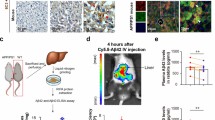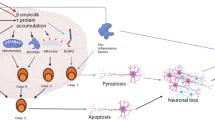Abstract
Hypoxia is one of the major common components of vascular risk factors for pathogenesis of Alzheimer’s disease. This study investigated the possible relationship between hypoxia and alternative splicing of the excitatory amino acid transporter 2 (EAAT2) in a transgenic model for Alzheimer’s disease. We used an APP23 mouse model prior to amyloid deposition and subjected it to chemical hypoxia treatment as induced by 3-nitropropionic acid. One hour after administration of 3-nitropropionic acid changes in the expression of the 5′-splice forms mEAAT2/5UT3, mEAAT2/5UT4, and mEAAT2/5UT5 were found in the frontal cortex, hippocampus and cerebellum of the APP23 model. In untreated APP23 animals the expression of EAAT2 splice variants was unchanged. Our results demonstrate that hypoxia facilitates alternative splicing of EAAT2 in the APP23 model. This may be a molecular mechanism linking vascular factors to early pathophysiology of Alzheimer’s disease.


Similar content being viewed by others
Abbreviations
- AD:
-
Alzheimer’s disease
- ALS:
-
Amyotrophic lateral sclerosis
- ANOVA:
-
Analysis of variance
- APP:
-
Amyloid precursor protein
- EAAT2:
-
Excitatory amino acid transporter 2
- 3-NP:
-
3-Nitropropionic acid
- uORF:
-
Upstream open reading frame
References
Snowdon DA, Greiner LH, Mortimer JA et al (1997) Brain infarction and the clinical expression of Alzheimer disease. The nun study. JAMA 277:813–817
Altieri M, Di Piero V, Pasquini M et al (2004) Delayed poststroke dementia: a 4-year follow-up study. Neurology 62:2193–2197
Schneider JA, Wilson RS, Cochran EJ et al (2003) Relation of cerebral infarctions to dementia and cognitive function in older persons. Neurology 60:1082–1088
Vermeer SE, Prins ND, den Heijer T et al (2003) Silent brain infarcts and the risk of dementia and cognitive decline. N Engl J Med 348:1215–1222
Honig LS, Kukull W, Mayeux R (2005) Atherosclerosis and AD: analysis of data from the US National Alzheimer’s coordinating center. Neurology 64:494–500
Heyman A, Fillenbaum GG, Welsh-Bohmer KA et al (1998) Cerebral infarcts in patients with autopsy-proven Alzheimer’s disease: CERAD, part XVIII. consortium to establish a registry for Alzheimer’s disease. Neurology 51:159–162
Milton ID, Banner SJ, Ince PG et al (1997) Expression of the glial glutamate transporter EAAT2 in the human CNS: an immunohistochemical study. Mol Brain Res 52:17–31
Li S, Mallory M, Alford M et al (1997) Glutamate transporter alterations in Alzheimer disease are possibly associated with abnormal APP expression. J Neuropathol Exp Neurol 56:901–911
Gegelashvili G, Robinson MB, Trotti D et al (2001) Regulation of glutamate transporters in health and disease. Prog Brain Res 132:267–286
Masliah E, Alford M, Mallory M et al (2000) Abnormal glutamate transport function in mutant amyloid precursor protein transgenic mice. Exp Neurol 163:381–387
Lauderback CM, Hackett JM, Huang FF et al (2001) The glial glutamate transporter, GLT-1, is oxidatively modified by 4-hydroxy-2-nonenal in the Alzheimer’s disease brain: the role of Abeta1-42. J Neurochem 78:413–416
Rodriguez-Kern A, Gegelashvili M, Schousboe A et al (2003) Beta-amyloid and brain-derived neurotrophic factor, BDNF, up-regulate the expression of glutamate transporter GLT-1/EAAT2 via different signaling pathways utilizing transcription factor NF-kappaB. Neurochem Int 43:363–370
Münch C, Schwalenstöcker B, Hermann C et al (2000) Differential RNA cleavage and polyadenylation of the glutamate transporter EAAT2 in the human brain. Mol Brain Res 80:244–251
Berger UV, DeSilva TM, Chen W et al (2005) Cellular and subcellular mRNA localization of glutamate transporter isoforms GLT1a and GLT1b in rat brain by in situ hybridization. J Comp Neurol 492:78–89
Rozyczka J, Engele J (2005) Multiple 5′-splice variants of the rat glutamate transporter-1. Brain Res Mol Brain Res 133:157–161
Honig LS, Chambliss DD, Bigio EH et al (2000) Glutamate transporter EAAT2 splice variants occur not only in ALS, but also in AD and controls. Neurology 55:1082–1088
Hoogland G, van Oort RJ, Proper EA et al (2004) Alternative splicing of glutamate transporter EAAT2 RNA in neocortex and hippocampus of temporal lobe epilepsy patients. Epilepsy Res 59:75–82
Münch C, Penndorf A, Schwalenstöcker B et al (2001) Impaired RNA splicing of 5′-regulatory sequences of the astroglial glutamate transporter EAAT2 in human astrocytoma. J Neurol Neurosurg Psychiatry 71:675–678
Münch C, Zhu BG, Schwalenstöcker B et al (2002) Alternative splicing of the 5′-sequences of the mouse EAAT2 glutamate transporter and expression in a transgenic model for amyotrophic lateral sclerosis. J Neurochem 82:594–603
Lauriat TL, Richler E, McInnes LA (2007) A quantitative regional expression profile of EAAT2 known and novel splice variants reopens the question of aberrant EAAT2 splicing in disease. Neurochem Int 50:271–280
Münch C, Zhu BG, Leven A et al (2003) Differential regulation of 5′-splice variants of the glutamate transporter EAAT2 in an in vivo model of chemical hypoxia induced by 3-nitropropionic acid. J Neurosci Res 71:819–825
Bornemann KD, Staufenbiel M (2000) Transgenic mouse models of Alzheimer’s disease. Ann NY Acad Sci 908:260–266
Cavaliere F, D’Ambrosi N, Ciotti MT et al (2001) Glucose deprivation and chemical hypoxia: neuroprotection by P2 receptor antagonists. Neurochem Int 38:189–197
Ludolph AC, Seelig M, Ludolph A et al (1992) ATP deficits and neuronal degeneration induced by 3-nitropropionic acid. Ann NY Acad Sci 648:300–302
Sturchler-Pierrat C, Abramowski D, Duke M et al (1997) Two amyloid precursor protein transgenic mouse models with Alzheimer disease-like pathology. Proc Natl Acad Sci USA 94:13287–13292
Chen GJ, Xu J, Lahousse SA et al (2003) Transient hypoxia causes Alzheimer-type molecular and biochemical abnormalities in cortical neurons: potential strategies for neuroprotection. J Alzheimers Dis 5:209–228
Maracchioni A, Totaro A, Angelini DF et al (2007) Mitochondrial damage modulates alternative splicing in neuronal cells: implications for neurodegeneration. J Neurochem 100:142–153
Pow DV, Naidoo T, Lingwood BE et al (2004) Loss of glial glutamate transporters and induction of neuronal expression of GLT-1B in the hypoxic neonatal pig brain. Brain Res Dev Brain Res 153:1–11
Morrish BC, Rumsby MG (2001) The 5′ UTR of protein kinase C epsilon confers translational regulation in vitro and in vivo. Biochem Biophys Res Commun 283:1091–1098
Yi JH, Pow DV, Hazell AS (2005) Early loss of the glutamate transporter splice-variant GLT-1v in rat cerebral cortex following lateral fluid-percussion injury. Glia 49:121–133
Maragakis NJ, Dykes-Hoberg M, Rothstein JD (2004) Altered expression of the glutamate transporter EAAT2b in neurological disease. Ann Neurol 55:469–477
Acknowledgment
This work was supported by a grant from the VERUM foundation.
Author information
Authors and Affiliations
Corresponding author
Rights and permissions
About this article
Cite this article
Münch, C., Zhu, Bg., Mink, A. et al. Chemical Hypoxia Facilitates Alternative Splicing of EAAT2 in Presymptomatic APP23 Transgenic Mice. Neurochem Res 33, 1005–1010 (2008). https://doi.org/10.1007/s11064-007-9540-5
Received:
Accepted:
Published:
Issue Date:
DOI: https://doi.org/10.1007/s11064-007-9540-5




